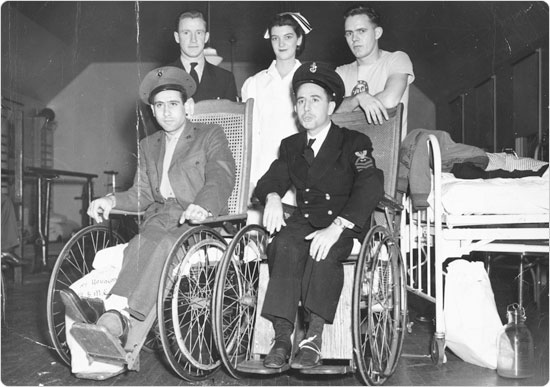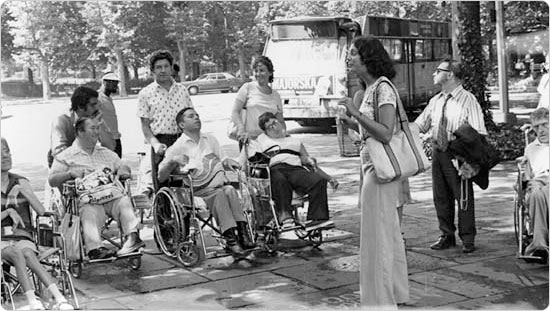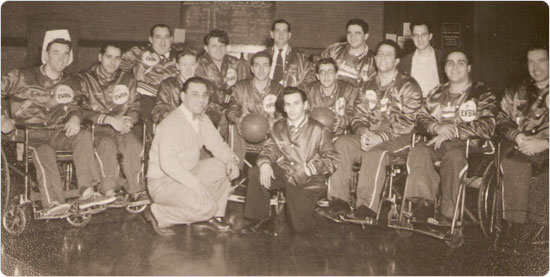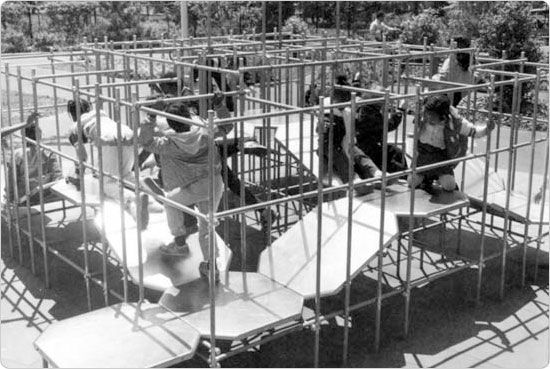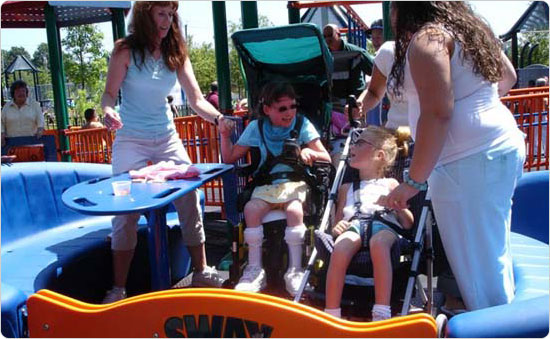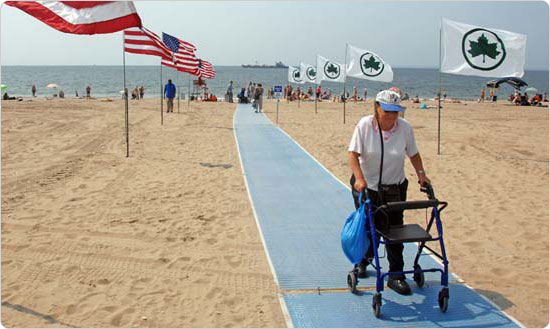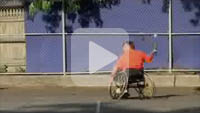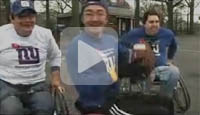History of Accessibility in Parks
The mission of a public park—perhaps even its definition—is to provide an open space that is free and accessible to all. Sadly, accessibility for people with disabilities has not always figured into this definition.
A municipality as old as New York City provides many challenges in making aging infrastructure compatible with the Americans with Disabilities Act (ADA). Its subway system, for example, is still decades away from providing access to people with disabilities in all of its 468 stations, and even the Parks Department's Arsenal headquarters was not fully accessible until 2005. Before then, maintenance workers would have to put temporary ramps in place for wheelchair-bound visitors.
The Parks Department is working to update its facilities so they are accessible to everyone and has made great strides in the years since President George H.W. Bush signed the original Americans with Disabilities Act in 1990.
“Parks & Recreation strives to help ALL New Yorkers discover New York City's 29,000 acres of parks, promoting physical and emotional well–being, and providing venues for fitness and relaxation,” said Parks & Recreation Commissioner Adrian Benepe. “Our goal is to go beyond compliance with the Americans with Disabilities Act (ADA) to provide access as well as increased opportunities for recreation. With programs ranging from ballroom dancing to sit aerobics and adaptive tennis, Parks is currently hard at work on an agency–wide transition plan to make all aspects of the Parks Department more accessible.”
Today, accessibility is a vital part of park construction, and Parks planners and designers take into account the abilities of all park patrons—something that was not always the case.
Early Challenges at Parks
At one time, people with disabilities were segregated from general society, if not through placement in special homes and schools, then in the de facto segregation brought by a lack of access to places that regularly abled people inhabited. Everything from stairways to train platforms to sidewalk curbs served to deny people with disabilities access to everything the city had to offer. The historical record is remarkably silent about how these people lived; in Parks records, for example, the word "disabled" instead was used to describe broken-down cars on a parkway, and "handicap" meant something to do with one's golf score.
Indeed, at one time, expanding access to patrons with disabilities seemed not to be on the Parks Department's radar. Parks official William H. Latham, responding to a suggestion by a concerned citizen to open portions of city pools to children with disabilities, wrote on April 28, 1939: "All of the City pools are already used to capacity during good swimming weather and it would not be practical to segregate a portion of any of them for such special use as you suggest. [Hospitals] Commissioner [Sigismund S.] Goldwater turned down a proposition for using the East 54 Street Swimming pool for this kind of use. I am sorry we cannot follow out your suggestion."
Other examples show an insensitive inability to anticipate the needs of people with disabilities. In July 1945, Commissioner Robert Moses had to release a statement to the press to allay the protests of returning war veterans when Parks officials inadvertently denied access to wheelchair-bound parkgoers at the Coney Island Boardwalk:
An unusual amount of publicity has been given to the alleged refusal of the Department of Parks to permit disabled veterans in wheelchairs to use park boardwalks. There is no general rule against such use. The boardwalk signs referred to by certain critics and placed there before the war state that no vehicles except baby carriages are permitted. These signs were aimed at bicycles, velocipedes and scooters which are prohibited under Section 45 of the Park Rules and Regulations, except at times and locations designated by the department. They were not aimed at individual veterans or invalids in wheelchairs, and, as a matter of fact, such wheelchairs are licensed at Coney Island where a similar sign is posted. These signs will now be changed and will read: PROHIBITED USE Any vehicle except baby carriages and wheelchairs for invalids.
Veterans Make Headway
The case of the returning veterans is notable in that it highlights an important aspect of the increased attention given to concerns about accessibility: those who returned from the war with casualties in numbers high enough for the general population to notice had to be cared for (World War II was the catalyst for many social changes, including equal rights for women and African-Americans).
The Disabled American Veterans organization, started after World War I, rose to new importance after World War II and took the lead in promoting equal rights for disabled veterans. Another quote from Robert Moses, responding to another controversy involving disabled veterans in July 1945, illustrates both the recent problem of accommodating disabled individuals and a focus on segregating the disabled from the general population:
Certain volunteer workers at Halloran Hospital have made an entirely false statement to the press to the effect that wounded-veterans in wheelchairs are excluded from City parks and specifically from boardwalks and beaches. There is no such ruling and thousands of veterans are being accommodated in both City and State parks including convalescents in wheelchairs. In addition, all sorts of special facilities have been made available and entertainments have been provided in cooperation with the doctors in charge of these and other service men.
The particular incident which led to this discussion occurred at Halloran Hospital, Staten Island. A doctor in charge of a ward in which there are badly wounded men, still in serious condition, conceived the idea of taking these men to beaches together with nurses, doctors and attendants. The first thought of this doctor and the various volunteer agencies, including the Red Cross, was to take these men to Jones Beach, It was pointed out that this was a two and one-half hour trip each way, that the men would be exhausted and that it would be a tough journey even for people in the best of health.
At this stage, an appeal was made to me, and I directed our executives to try in every possible way to work out something satisfactory, as an experiment, either at Roosevelt Beach or at Wolfe's Pond, Staten Island. After a field inspection with representatives of the volunteer groups, we offered a section of the Roosevelt boardwalk with adequate access. Our information was that the party was to consist of twenty-six wounded veterans and sufficient nurses, doctors and attendants to raise the total to one hundred twenty-five people. Not only was a great deal of time and effort given to making this experiment a success, but I personally began a study of other means of entertaining men in this location especially through boat excursions.
Just before the time came for the experiment, additional conditions were imposed and arbitrary demands by the Halloran volunteer group which would have made it impossible for us successfully to carry out the plan. It turned out that the idea back of the experiment was that these veterans should mingle with public crowds in the face of the fact that they are seriously wounded cases requiring constant attention of a large number of nurses and doctors, especially on park trips of this kind. Under these circumstances, the park officials must find means of protecting them from curiosity seekers, small children, etc.
The success of an experiment of this sort depends not only upon knowledge of nursing but of park operation. Under the conditions, we were forced to notify the hospital people that we could not attempt the experiment in the face of the arbitrary and unworkable orders they insisted upon.
It may be noted in passing that precisely the opposite conclusion as to recreation for seriously wounded men has been reached by practically all of the other doctors in the armed services with whom we have had contacts. For example, we have provided for Navy convalescents at the Half Moon Hotel a section of beach roped off at the insistence of the Navy doctors who said it would be impossible to care for these men adequately and to preserve order unless they had a beach exclusively for their use.
Slowly Changing Mindsets and Landscapes
By the 1960s, Parks had began to consider the needs of patrons with disabilities, even if fully accessible construction was still decades away. A press release from 1961 gives instructions for entering Central Park, noting that "The entrance at 67th Street and Fifth Avenue is more suitable for use by patrons with baby carriages and for handicapped people as it has a graded path entrance." And the Brownsville Recreation Center in Brooklyn hosted a season's worth of wheelchair basketball in 1963-64. The Brooklyn Whirlaways Wheelchair Basketball Team opened their 15th season of play against the Eastern Paraplegic Veterans, and the eight home games featured teams from as far away as Philadelphia and Richmond. The free games, played by athletes with disabilities, increased awareness of disabilities.
The 1960s saw increased concern about accommodating people with disabilities but not necessarily including them. In 1966, Adam West and Bert Ward, who played Batman and Robin in the television version of the comic book, gave awards to local youths for good citizenship. The actors then made "some unannounced trips to other Park Department facilities, accompanied by Commissioner Hoving, to greet handicapped children who will not be able to join the gala party in the Park." Many Parks programs for children separated children with disabilities, lumping them together with children with mental retardation in separate programs (the word "handicapped" was often used interchangeably to mean having either physically and mentally disabilities). Until schools began to "mainstream" differently abled children, children with disabilities were sent to separate schools, and accommodations were made in this respect. But as educational theories changed, and mainstreaming became the norm, attention turned to accommodating people with disabilities without segregating them.
A Landmark for Parks
By the 1980s, a new understanding of physical disability and the need to integrate all members of society set the backdrop for the Playground for All Children in Flushing Meadows Corona Park, dedicated in 1984 as the first facility of its kind in either New York City or the United States. Revolutionary in that it engaged both disabled and able-bodied children, it served as a prototype for similar facilities elsewhere. Parks collaborated with the Department of City Planning, architects, and community and advocacy groups for the disabled on its design and construction. Built to accommodate children using crutches, canes, walkers, or wheelchairs, the playground also provides opportunities for social, cognitive, sensory, and motor activity. Its features include ramped play equipment, ground level play features, accessible swings, and wheelchair-accessible tables and drinking fountains.
Progress at Playgrounds
Today there are six Playgrounds for All Children in New York City parks: Pelham Bay Park in the Bronx (2000); Central Park's Bendheim Playground (1997), Playground 70 (2003) and Vesuvio Playground in Manhattan (2007); Flushing Meadows Corona Park in Queens (1984); and Bloomingdale Park on Staten Island (2006). In addition, Playground 70 in Manhattan was constructed in partnership with Boundless Playgrounds, a nonprofit group that assists communities in planning fully accessible playground facilities.
And more playgrounds are becoming accessible each year, so that there are dozens of options throughout the five boroughs. Parks groups its accessible playgrounds into four levels: Level 1, Playgrounds for All Children; Level 2, Accessible Playgrounds with Ramped Play Equipment and Universally Accessible Swings; Level 3, Accessible Playgrounds with Universally Accessible Swings; and Level 4, Accessible Playgrounds with Transfer Platforms and Ground Level Play Features. View a full list of accessible playgrounds, including the specific definitions of each level.
Equally amusing for children, the Carousel For All Children in Staten Island's Willowbrook Park, opened in 1999, is not only a turn-of-the-century Victorian style merry-go-round but also the first carousel in the parks system that is completely accessible.
Making changes to play spaces isn't all Parks has done to improve its record. In recent years, the department has strengthened its commitment to improved accessibility for people with disabilities by appointing an ADA Coordinator who oversees accessibility issues, trains Parks Managers on such matters, and surveys Parks facilities like comfort stations, recreation centers, and beaches to make ADA-compatible improvements. For more on accessibility issues, please consult our Accessibility webpage (which itself is in the continuing process of adhering to Web Content Accessibility Guidelines).
Facilities and Programming for All Abilities
Parks has even increased accessibility at its beaches. In 2007, the agency purchased "Mobi-Mats," blue heavy-duty polyester mats that are positioned at access points along the boardwalk and anchored into the sand to provide a smooth level surface for wheelchairs. The mats made their debut at the Rockaways in Queens, on Orchard Beach in the Bronx, on Midland Beach in Staten Island, and at Brighton Beach in Brooklyn.
Also on the summer fun front, Parks has installed chair lifts at all outdoor Olympic and intermediate pools and two mini–pools. Now it's easy for everyone to get cool on hot days.
Programs such as I FISH NY, a joint project run by New York Sea Grant and the Department of Parks & Recreation, offer clinics, free of charge, to introduce people with disabilities to the sport of fishing. Sled Hockey games have taken place at Lasker Rink in Central Park, and Sit Fitness classes, designed to help seniors and people with mobility limitations, are offered at recreation centers to encourage upper body strengthening and a cardiovascular workout. Wheelchair tennis is played on courts across the five boroughs, with the USTA Billie Jean King National Tennis Center recently hosting its 8th Annual Jana Hunsaker Memorial Wheelchair Tennis Tournament, as well as a Wheelchair Tennis Clinic for Disabled Children.
An example of how far we have come since the days when people with disabilitieswere simply sent away to homes can be seen in the example of the JennSwing. The JennSwing, a specially designed semi-reclined swing, has been installed in playgrounds across the city since 1998. The swing is both suitable for children with special needs and fun for nondisabled children, to the point where most kids do not even know it is ADA-compliant, and disabled children get admonished for "hogging the swing." As the JennSwing shows, it is possible to make parks accessible to all to everyone's advantage.
Related Links
BeFitNYC: Accessible Facilities, Programs, and Leagues
Carousel for All Children
Parks Accessibility Settings and Info
Parks Programs

